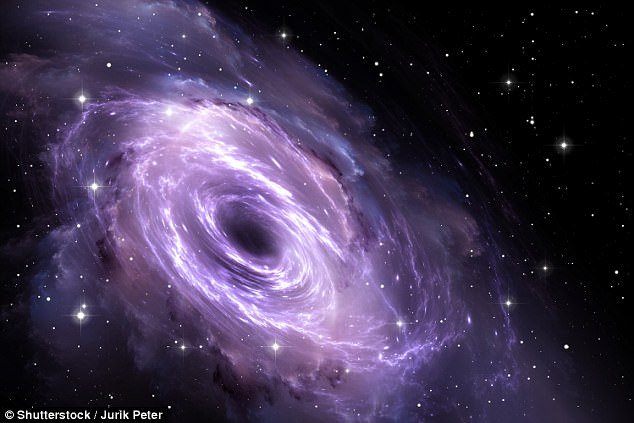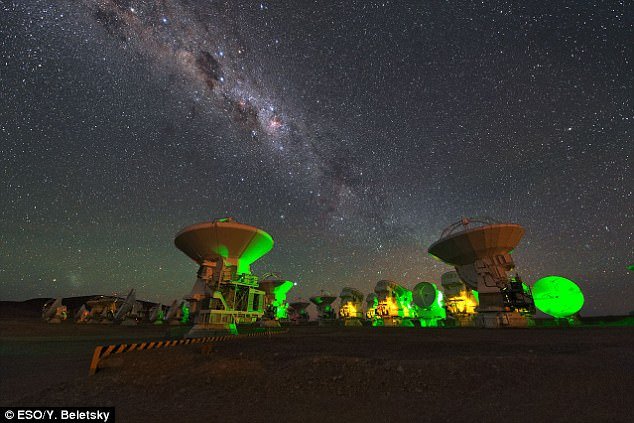Monster black hole 100,000 times more massive than the sun is found in the heart of our galaxy
A giant black hole 100,000 times more massive than the sun has been in the heart of our galaxy.
The monster black hole is the second largest ever seen in the Milky Way after the supermassive black hole Sagittarius A*.
It was discovered hiding in a toxic gas cloud 25,000 light years from Earth by Japanese astronomers.
Dubbed a 'intermediate-mass black holes', it fills a gap in astronomer’s knowledge about how supermassive black holes objects form.
The black hole was found hiding in a cloud of molecular gas by astronomers using the Alma (Atacama Large Millimeter/submillimeter Array) 16,400 feet above sea level in the Andes in northern Chile.
The radio telescope's high sensitivity and resolution enabled them to observe the cloud 195 light years from the Milky Way's centre spot.
These intermediate-mass black holes black holes were believed to exist but none had ever actually been identified - until now.
Recent research has shown supermassive black holes are essential to the creation of galaxies, stars - and even life itself.
Each one is about half a per cent of the host galaxy's size - which indicates they are the driving force behind their evolution.
The finding published in Nature Astronomy provides important insights into how supermassive black holes like the one at the very centre of our galaxy were created.
Although it is well established they reside in seemingly all galaxies we do not know how they get so enormous.
This is despite them appearing to have been in place when the universe was comparatively young - only a few hundred million years old.
It's believed they could be the seeds of their more massive counterparts - merging together to form a gigantic one.
Intermediate black holes might simply turn out to be their progenitors.
It's difficult to find black holes - because they are completely black. But in some cases they cause effects which can be seen.
A black hole is a region of space that has such an extremely powerful gravitational field that it absorbs all the light that passes near it and reflects none.
Professor Tomoharu Oka and colleagues used computer simulations to show the high velocity motion, or kinematics, of the gas could only be explained by an intermediate black hole concealed in its midst.
They also found the emission from this cloud closely resembles a scaled-down version of the Milky Way's quiescent supermassive black hole.
Professor Oka, of Keio University in Japan said it is widely accepted black holes with masses greater than a million solar masses lurk at the centres of massive galaxies, but their origins remain unknown.
He said: 'One possible scenario is intermediate-mass black holes (IMBHs) - which are formed by the runaway coalescence of stars in young compact star clusters - merge at the centre of a galaxy to form a supermassive black hole.
'Although many candidates for IMBHs have been proposed none is accepted as definitive. Recently we discovered a peculiar molecular cloud near the centre of our Milky Way galaxy.
Based on the careful analysis of gas kinematics we concluded a compact object with a mass of about 100,000 solar masses is lurking in this cloud.'
Professor Oka said it suggests 'this massive object is an inactive IMBH which is not currently accreting matter.'
Despite their popularity both in real science and science fiction the concept of a black hole has only been around for a hundred years - as predicted by Albert Einstein.
'The term itself did not come into use until 1967, and it was just 46 years ago that the first one was identified.
Professor Oka said: 'Further detection of such compact high-velocity features in various environments may increase the number of non-luminous black hole candidate and thereby increase targets to search for evidential proof of general relativity.
'This would make a considerable contribution to the progress of modern physics.'


Black holes are one of the most interesting topics because there is so much that we don't know about them. They underline just how vast space is a how small we are in comparison!
Hi! I am a robot. I just upvoted you! I found similar content that readers might be interested in:
http://expressdigest.com/monster-black-hole-is-found-in-our-galaxy/
Nice topic
nice article!!
I am very happy with this important topic
Good